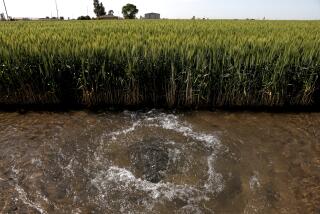Bush Officials Try Again on a Strategy to Protect Wetlands
WASHINGTON — Striving to fix a controversial policy announced late last year, Bush administration officials unveiled a plan Thursday to stop the loss of wetlands across the country.
The first stage in a multiyear, multi-agency strategy will take effect today when the Army Corps of Engineers issues its revision of a much-criticized guidance letter, officials said.
The guidance letter specifies what kind of mitigation Corps engineers can allow to make up for wetlands that developers destroy during construction of roads, buildings or other projects. When it was released in October 2001, the guidance letter was broadly attacked by environmentalists in Congress and across the country as the Bush administration’s abandonment of the goal of “no net loss” of wetlands, set by former President Bush in 1989.
Wetlands -- marshes, swamps and bogs -- are complex ecosystems that can serve a variety of valuable roles. They improve water quality, control floods, diminish droughts and stabilize shorelines. They also are home to many rare or endangered plants and animals.
Before the 1970s, wetlands were destroyed indiscriminately because their ecological value was not broadly acknowledged. By the 1970s, the contiguous United States had only half as much wetland area as it did 200 years earlier.
The new policy is a direct response to criticisms of the initial guidance letter and an effort to bring the nation’s approach to wetlands mitigation in line with recommendations the National Academy of Sciences made last year, said Ben Grumbles, assistant administrator for water at the Environmental Protection Agency.
Officials also outlined 16 steps they plan to take to ensure that developers avoid destroying wetlands when possible and act more responsibly to protect ecosystems if wetlands must be destroyed during building projects.
“These actions affirm this administration’s commitment to the goal of no net loss of America’s wetlands and its support for protecting our nation’s watersheds,” EPA administrator Christie Whitman said in a draft news release.
But critics are holding off final judgment until they see the fine print in the Corps’ guidance letter.
“We’re pleased to see them at least initially taking the right steps to examine how to improve mitigation, given its high rate of historic failure,” said Julie Sibbing, a wetlands policy specialist for the National Wildlife Federation, an environmental organization. “But we’d like to see real concrete commitment to improving mitigation right now.”
Grumbles said the revised guidance letter specifically directs Corps engineers to consider the recommendations of the National Academy of Sciences and the goals of watershed preservation and no net loss of wetlands. It also requires engineers to avoid wetlands loss when possible.
He said that as a result of the revised letter, engineers will less frequently allow developers to compensate for lost wetlands by planting trees and shrubs near waterways, or fashioning new wetlands in another location.
The new policy sets deadlines for officials to decide about the techniques that developers can use to make up for wetlands losses in the future.
By the end of next year, the federal agencies must produce a policy stating when developers can compensate for a lost wetland by creating a new wetland in another location.
By 2004, officials will have to decide whether developers can compensate for lost wetlands by constructing vegetation buffer zones, which can serve only some of the purposes of wetlands.
Sibbing stressed that the government would not be living up to its no net loss goal if it allowed developers to compensate for destroying wetlands by planting trees or shrubs along a waterway.
“Then they’re not making up for anything destroyed,” she said.
The new policy also requires federal agencies to produce an annual nationwide report card by 2005, assessing how effective the mitigation efforts have been at protecting ecosystems and watersheds.
“The net effect is it’s going to ensure greater accountability and a watershed-based approach to analyzing what types of wetlands mitigation should be used,” Grumbles said.
The federal government lacks up-to-date data on the loss of wetlands nationwide. But the U.S. Fish and Wildlife Service has estimated that an average of 58,000 acres of wetlands was lost annually from 1956 to 1987. The loss slowed significantly over the next decade, according to the National Academy of Sciences. But the goal of no net loss of wetlands is far from being met, the academy said.
More to Read
Sign up for Essential California
The most important California stories and recommendations in your inbox every morning.
You may occasionally receive promotional content from the Los Angeles Times.










